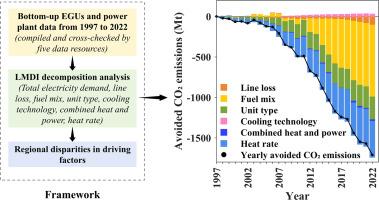中国电力行业通过结构变革和效率提升来避免二氧化碳排放:一个发电机组层面的分析
IF 10.9
1区 环境科学与生态学
Q1 ENGINEERING, ENVIRONMENTAL
引用次数: 0
摘要
本研究以中国电力行业为研究对象,编制了由上而下的发电机组热率与CO2排放综合时间序列数据集,并对各技术因素对CO2减排的贡献进行了分解。结果表明,巨大的结构变化和效率提高使全国最终电力消费的平均二氧化碳强度从1997年的983.3 g CO2/kWh降低到2022年的544.9 g CO2/kWh,累计避免了158亿吨潜在的二氧化碳排放。燃料结构调整(38.3%,6055 Mt)、热率降低(35.0%,5527 Mt)和增装egu (23.2%, 3661 Mt)是二氧化碳减排的三大因素。基于自下而上数据集的分解分析捕获了EGU层面的详细技术和结构变化,从而能够更精确地评估替代脱碳政策的影响。由于传统燃煤发电提高能源效率的潜力正在缩小,未来的政策应侧重于低碳改造的新领域。本文章由计算机程序翻译,如有差异,请以英文原文为准。

Avoided CO2 emissions in China’s power sector by structural change and efficiency gain: An electric generating unit level analysis
In this study, we compile a comprehensive time-series bottom-up dataset of heat rate and CO2 emission at the electric generating unit (EGU) level for China’s power sector, and decompose contributions of various technological factors to CO2 emission reduction. Results show that dramatic structural change and efficiency gain have reduced the national average CO2 intensity of final electricity consumption from 983.3 g CO2/kWh in 1997 to 544.9 g CO2/kWh in 2022, cumulatively avoiding 15.8 billion tonnes of potential CO2 emission. Fuel mix adjustment (38.3 %, 6055 Mt), heat rate decrease (35.0 %, 5527 Mt), and upsizing of EGUs (23.2 %, 3661 Mt) are the top three factors for CO2 mitigation. Decomposition analysis based on the bottom-up dataset captures detailed technological and structural changesat the EGU level, enabling a more precise evaluation of the effects of alternative decarbonization policies. As potentialfor energy efficiency improvement of traditional coal-fired power generation is shrinking, future policies should focus on new areas of low-carbon retrofits.
求助全文
通过发布文献求助,成功后即可免费获取论文全文。
去求助
来源期刊

Resources Conservation and Recycling
环境科学-工程:环境
CiteScore
22.90
自引率
6.10%
发文量
625
审稿时长
23 days
期刊介绍:
The journal Resources, Conservation & Recycling welcomes contributions from research, which consider sustainable management and conservation of resources. The journal prioritizes understanding the transformation processes crucial for transitioning toward more sustainable production and consumption systems. It highlights technological, economic, institutional, and policy aspects related to specific resource management practices such as conservation, recycling, and resource substitution, as well as broader strategies like improving resource productivity and restructuring production and consumption patterns.
Contributions may address regional, national, or international scales and can range from individual resources or technologies to entire sectors or systems. Authors are encouraged to explore scientific and methodological issues alongside practical, environmental, and economic implications. However, manuscripts focusing solely on laboratory experiments without discussing their broader implications will not be considered for publication in the journal.
 求助内容:
求助内容: 应助结果提醒方式:
应助结果提醒方式:


